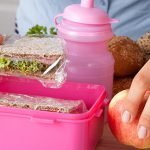Beat the lunch box blues
Do you dread opening your child’s lunch box at the end of the day? All that hard work, only to find soggy, half-eaten sandwiches, limp and faded carrot sticks, battered yellow apple slices. It’s no wonder parents look forward to the end of the school year. No more lunches to pack… until school rolls around again.
To help you escape the lunch-time rut, we turned to J.M. Hirsch, national food editor for the Associated Press, who blogs about packing school lunch for his son, Parker. Hirsch, who shares his school lunch secrets on The Martha Stewart Show, has so successfully managed to fill his 7-year-old son’s lunch box with enticing options that it’s caught the attention of his elementary school classmates. "My son has become a de facto leader in his lunch room,” says Hirsch. “His friends — and their parents — look to his lunches for inspiration."
Make this semester one your child will remember — and savor — with these seven secrets to school lunch success.
Happy packing!
-
Keep it simple
Think outside the traditional lunch box by offering several small (and healthy) choices that kids can use to create a whole meal.
"Kids love to get hands on and assemble their own meals,” says Hirsch. “That’s one reason [packaged lunch kits] are so popular. Save money and make a healthier choice — make your own."
Consider packing three to four complementary ingredients, and then letting your child put them all together at lunchtime: a slice or two of whole wheat bread or a handful of crackers; chunks of cheese and sliced meats; grapes and cherry tomatoes; hummus with pita wedges or carrot and cucumber sticks; and apple slices (tossed in lime juice to retain color). A scoop of peanut (or other nut) butter and whole-grain pita pockets are another no-fuss option, as are lettuce wraps (baby gem or romaine lettuce leaves filled with cottage cheese or guacamole).
-
Stick with what they know (and like)
School lunch is not the time to introduce fried squid or wasabi roasted kale if your child has never tasted those particular delicacies. Your lunchtime goal is straight and simple: you want your child to get the nutrients he needs to do well in school. Or, as Hirsch likes to say, "Save the green bean battles for dinner."
Your child’s lunch should include protein for that busy brain, complex carbohydrates for energy, and fruit and vegetables for vitamins, minerals, and fiber. But don’t jam your child’s lunch box with healthy stuff she’s unlikely to eat, advises Hirsch. "It’s better to work with your child to find foods that are both appealing and healthy. This means taking your kid shopping and talking about food and nutrition."
-
Compartmentalize
There’s something about meals served in their own compartments that even older kids love, which is why bento box-style lunch boxes with multiple small sections are such a hit with the school-age set.
In addition, says Hirsch: "They force me to be creative and come up with different items. When you have four or five small containers to fill, it’s harder to just crank out yet another PB&J. It also makes it easier to feel okay about slipping in treats. If you fill one compartment with a cookie, you know to focus the rest on healthier choices."
Compartments can also boost a food’s appeal. Few kids will eat a limp salad, for example, but keeping the dressing in a separate container can solve the problem. (Check out these ideas for cool green lunch containers).
-
Looks matter
When it comes to food, looks matter — a lot. Many kids (and adults, too) refuse food that doesn’t look appetizing. This doesn’t mean you have to fashion food into fancy shapes. Instead, do what professional chefs do: serve foods in small portions that whet, rather than overwhelm, the appetite (another reason to invest in a lunch box with compartments). A fruit kebab is more enticing than a whole apple. Mini bagels, too, are more appealing than the standard size options.
-
Reuse and recycle
Leftovers get a bad rap, but last night’s dinner can be transformed into something original and tasty for the next day’s lunch.
Rice, beans, and roast chicken can show up in your child’s lunch box later in the week, transformed into rice balls, bean burritos, and chicken wraps. Chicken pieces can form the basis of a salad, and extra pasta can be tossed with peanut butter for cold peanut noodles. Even better, as Hirsch points out, none of these ideas require any additional cooking.
-
Make it fun
PB&Js day after day get old, even for the fussiest eater, so surprise your child by giving lunch a touch of creativity.
Pack breakfast for lunch with separate containers of granola, yogurt, and berries that your kid can mix together at lunchtime. Or skip the sandwich bread and substitute a whole wheat tortilla for a twist.
At Hirsch’s house, mango chutney and cream cheese sandwiches are a hit, as is peanut butter and jelly served on leftover whole wheat pancakes instead of bread. Then there’s the infamous spaghetti taco, which suggests no end of taco variations guaranteed to amuse — and hopefully tempt — your child.
-
Get your child involved
Be sure to bring your child on board at every step of the lunch-making process: planning, prepping, and packing.
Hirsch indulged his son’s request for a peanut butter and pretzel sandwich, which he made with whole-wheat bread, sugar-free peanut butter, and multi-grain pretzels. "It turned out to be a winner," he says. "He didn’t care that I used healthy ingredients because it was his idea."
Hirsch is a fan of the compromise: "If kids feel like you listen to their ideas, they are more invested in the process and more likely to eat what you pack them."
Check out 26 more creative lunch ideas from around the world.






